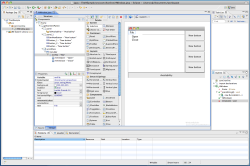Eclipse Indigo expands its reach
 The annual Eclipse release train has pulled into the station and is delivering the last twelve months' worth of of work carried out by 62 project teams, 408 developers and 49 organisations in the ten ready-to-download packages that make up Eclipse Indigo. The annual release train synchronises Eclipse projects in releasing their newly enhanced projects at the same time, ready packaged for developers and vendors to use. Mike Milinkovich, executive director of the Eclipse Foundation, was "proud to celebrate another on-time annual release train from the Eclipse community".
The annual Eclipse release train has pulled into the station and is delivering the last twelve months' worth of of work carried out by 62 project teams, 408 developers and 49 organisations in the ten ready-to-download packages that make up Eclipse Indigo. The annual release train synchronises Eclipse projects in releasing their newly enhanced projects at the same time, ready packaged for developers and vendors to use. Mike Milinkovich, executive director of the Eclipse Foundation, was "proud to celebrate another on-time annual release train from the Eclipse community".

![]() WindowBuilder integrates deep into Eclipse
Java developers are well catered for in Indigo. One highlight in particular comes from Google, who donated WindowBuilder to the Eclipse project after acquiring Instantiations; this has given Eclipse a high power GUI editor with complete source to design to source round-tripping. WindowBuilder can handle both SWT and Swing UI design with drag and drop creation, addition of event handlers and visual property editors. But a great GUI is nothing without the ability to test it, which is where another new addition to Eclipse comes in: Jubula is an automated functional GUI testing tool for Java and HTML applications. Tests can be created by dragging and dropping pre-created test elements, without programming, and can be brought together as modules which form test suites.
WindowBuilder integrates deep into Eclipse
Java developers are well catered for in Indigo. One highlight in particular comes from Google, who donated WindowBuilder to the Eclipse project after acquiring Instantiations; this has given Eclipse a high power GUI editor with complete source to design to source round-tripping. WindowBuilder can handle both SWT and Swing UI design with drag and drop creation, addition of event handlers and visual property editors. But a great GUI is nothing without the ability to test it, which is where another new addition to Eclipse comes in: Jubula is an automated functional GUI testing tool for Java and HTML applications. Tests can be created by dragging and dropping pre-created test elements, without programming, and can be brought together as modules which form test suites.
Sharing well is the mark of a good team and, in Eclipse Indigo, that sharing is assisted by the addition of EGit, which only this week left the incubator. EGit adds Git distributed version control support to Eclipse – with the rapidly growing popularity of Git and services like GitHub, EGit fills in a version control gap in the Eclipse armoury. A Java-based Git library, JGit, underlies EGit but is available for any project which wants to integrate Git into their application; it is also used in the Gerrit code review tool and NBGit, Git for NetBeans.
Maven, the software project management tool, is now more integrated with Eclipse; m2eclipse offers first class support for editing Maven pom.xml files, running a build from the IDE and generally simplifying the consumption of Maven artifacts from within Eclipse.
Mylyn, the task management framework for Eclipse, has been enhanced in Eclipse Indigo to allow Hudson/Jenkins activity to feed into the task management system. There are also numerous additions to Mylyn including the display of Gravatar images of assignees for tasks, delayed capture of screenshots, content specific icons, update notifications, automatic use of stack traces to populate contexts when viewing tasks with stack traces and many more changes designed to bring together the elements involved in an application's lifecycle.
The client for the Eclipse's "App Store", the Eclipse Marketplace, has also been enhanced with drag and drop installation of "solutions" from the marketplace, better branding for third party catalogs, and the ability to share a link to a particular solution via email or Twitter.
Eclipse Modelling also saw a number of enhancements. Xtext 2.0 has begun to allow DSLs with Java-like expressions and has added a new template language, Xtend, that integrates into the Eclipse tooling. Acceleo 3.1, which converts models into code, adds support for integrating code generation into Ant and Maven build processes. NoSQL database support has been added to the CDO Model Repository so that Objectivity/DB, MongoDB and DB40 can be used and its cache has been optimised to allow for models of several gigabytes. There have also been enhancements to EMF (Eclipse Modelling Framework) with easier, more efficient replication on distributed systems, a new editing framework (EEF) for one-click creation of "advanced and good-looking" EMF editors, dedicated UML support for EMF Compare and the addition of EMF Facet, for extending models without modification.
EclipseRT, the runtime technology project, has seen a number of improvements too. The EclipseLink persistence technology now supports multi-tenant JPA entities, which adds a tenant discriminator to each entity and, in turn, allows those entities to be co-located in a single table. Equinox, the OSGi framework implementation, has been upgraded to support the generic signatures and generic capabilities of the OSGi 4.3 specification and the Eclipse Communication Framework now implements OSGi Remote Service and Service Admin 4.2.
Eclipse Indigo is available to download from the Eclipse mirrors or it can be torrented. Eclipse is released under the Eclipse Public Licence.
(djwm)
![Kernel Log: Coming in 3.10 (Part 3) [--] Infrastructure](/imgs/43/1/0/4/2/6/7/2/comingin310_4_kicker-4977194bfb0de0d7.png)

![Kernel Log: Coming in 3.10 (Part 3) [--] Infrastructure](/imgs/43/1/0/4/2/3/2/3/comingin310_3_kicker-151cd7b9e9660f05.png)
















